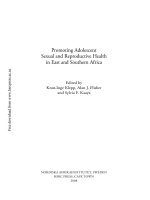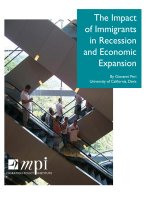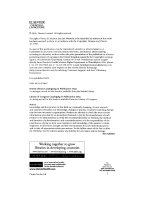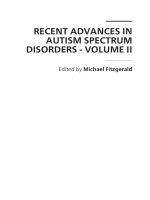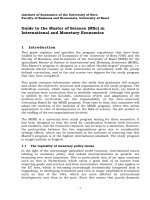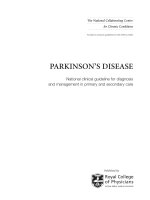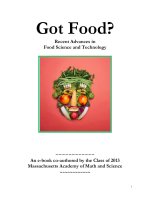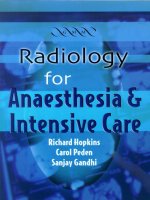Recent Advances in Anaesthesia and Intensive Care ppt
Bạn đang xem bản rút gọn của tài liệu. Xem và tải ngay bản đầy đủ của tài liệu tại đây (15 MB, 323 trang )
Recent Advances in
Anaesthesia and Intensive Care
22
Aic22-FM.qxd 9/11/02 1:40 PM Page i
This page intentionally left blank
LONDON
᭹
SAN FRANCISCO
Recent Advances in
Anaesthesia and Intensive Care
Edited by
A.P. Adams MB BS, MRCS, LRCP, PhD, DA, FRCA, FANZCA
Emeritus Professor of Anaesthetics
University of London
Honorary Consultant Anaesthetist
Guy’s, King’s and St Thomas’ Hospitals
London, UK
Emeritus Consultant to the Army
J.N. Cashman BSc, MB BS, BA, MD, FRCA
Consultant Anaesthetist, St George’s Hospital, London
Honorary Senior Lecturer in Anaesthesia
University of London, UK
R.M. Grounds MB BS, MRCS, LRCP, MD, DA, FRCA
Consultant in Anaesthesia and Intensive Care Medicine
St George’s Hospital, London
Honorary Reader in Intensive Care Medicine
University of London, UK
22
www.greenwich-medical.co.uk
© 2003
Greenwich Medical Media Limited
137 Euston Road
London
NW1 2AA
870 Market Street, Ste 720
San Francisco
CA 94102
ISBN 1 84110 1176
First Published 2003
While the advice and information in this book is believed to be true and accurate, neither the authors nor the publisher
can accept any legal responsibility or liability for any loss or damage arising from actions or decisions based in this
book. The ultimate responsibility for the treatment of patients and the interpretation lies with the medical practitioner.
The opinions expressed are those of the authors and the inclusion in this book of information relating to a particular
product, method or technique does not amount to an endorsement of its value or quality, or of the claims made by its
manufacturer. Every effort has been made to check drug dosages; however, it is still possible that errors have occurred.
Furthermore, dosage schedules are constantly being revised and new side-effects recognised. For these reasons, the
medical practitioner is strongly urged to consult the drug companies' printed instructions before administering any of
the drugs mentioned in this book.
Apart from any fair dealing for the purposes of research or private study, or criticism or review, as permitted under
the UK Copyright Designs and Patents Act 1988, this publication may not be reproduced, stored, or transmitted, in
any form or by any means, without the prior permission in writing of the publishers, or in the case of reprographic
reproduction only in accordance with the terms of the licences issued by the appropriate Reproduction Rights
Organisations outside the UK. Enquiries concerning reproduction outside the terms stated here should be sent to the
publishers at the London address printed above.
The rights of A.P. Adams, J.N. Cashman & R.M. Grounds to be identified as editors of this work have been asserted
by them in accordance with the Copyright Designs and Patents Act 1988.
The publisher makes no representation, express or implied, with regard to the accuracy of the information contained
in this book and cannot accept any legal responsibility or liability for any errors or omissions that may be made.
A catalogue record for this book is available from the British Library
Typeset by Mizpah Publishing Services, Chennai, India
Printed in the UK by the Alden Group Ltd, Oxford
Distributed by Plymbridge Distributors Ltd and in the USA by Jamco Distribution
Contents
Preface vii
A.P. Adams, J.N. Cashman, R.M. Grounds
Contributors xi
1. The COX enzyme system 1
D. Bishop-Bailey, T.D. Warner
2. Drug chirality: stereoselectivity in the action and 31
disposition of anaesthetic agents
A.J. Hutt
3. New local anaesthetics 65
G.A. McLeod
4. Asthma 95
L. Cormican, J. Rees
5. Reducing mortality and complications in patients 117
undergoing surgery at high risk for postoperative
complications and death
R.M. Grounds
6. Prone ventilation of the lungs 135
L. Gattinoni, D. Chiumello, P. Pelosi
7. Antibiotics and nosocomial infection in the ICU 159
J. Chastre, J L. Trouillet
8. Neuropathic pain 177
A.B. Petrenko, T. Yamakura, H. Baba, K. Shimoji
9. Managing medical mishaps: learning lessons from industry 209
D. Parker, R. Lawton
10. Legal issues in anaesthesia and intensive care 223
E. Hallinan, N.J.H. Davies
11. Education and training in anaesthesia 237
G. Stanley, J.N. Cashman
12. Resuscitation 259
E. Rowland, H. Binns
Index 301
vi Contents
Aic22-FM.qxd 9/11/02 1:40 PM Page vi
Preface
“An intellectual is a man
who takes more words than necessary
to tell more than he knows.”
Dwight D. Eisenhower (1890–1969)
In 1932 J & A Churchill Ltd published the first edition of Recent Advances
in Anaesthesia and Analgesia (Including Oxygen Therapy). Nearly 70 years
later we commented in the Preface to the Millennium (21st) edition of Recent
Advances in Anaesthesia and Analgesia that the pace of advances in anaes-
thesia showed no sign of abating. Although 2 years further on this statement
remains true, change has now affected the title as well. Harcourt Publishers
Ltd has transferred the title from Churchill Livingstone to Greenwich
Medical Media Ltd. Coincident with the transfer it was decided to include
more Intensive Care Medicine topics and consequently the title has been
changed to Recent Advances in Anaesthesia and Intensive Care. In association
with this change, we are pleased that Dr Michael Grounds has joined the
editorial team.
The range of topics covered in this issue represent all aspects of anaesthesia
from basic science to clinical practice, from training the anaesthetists of
the future to relevant medical conditions, from optimization of patients to
resuscitation of patients. As always, the editors are grateful to the many
distinguished colleagues who have contributed to Recent Advances in Anaes-
thesia and Intensive Care – 22. The first three chapters present developments
in pharmacology. It is now appreciated that there are two related, but unique
isoforms, of the cyclo-oxygenase (COX) enzyme, which play important
but different physiological and pathophysiological roles. An understanding
of the differences between COX-1 and COX-2 is necessary for the logical
development of new anti-inflammatory drugs. In their chapter on The COX
Enzyme System, Dr Bishop-Bailey and Prof. Warner clearly elucidate these
Aic22-FM.qxd 9/11/02 1:40 PM Page vii
differences and their significance. Over recent years, drug stereochemistry
has become a topic of considerable interest, with much discussion on the
relative merits of using single isomer versus racemic mixtures of chiral drugs.
Advances in chiral technology permit the commercial synthesis of single-
isomer compounds. Dr Hutt considers the relevance of drug chirality to
anaesthesia. With all of this interest in drug stereochemistry it is probably no
surprise that chirality has been important in the development of new local
anaesthetic agents. In his chapter on New Local Anaesthetics, Dr McLeod
describes in detail recent advances in molecular biology with respect to nerve
conduction as well as concepts of the method of action of local anaesthetics;
he discusses both levobupivacaine and ropivacaine in detail.
The prevalence of asthma in society has increased dramatically over the
past 30 years and at the same time the death rate has also been increasing
alarmingly. Drs Cormican and Rees suggest that the reasons for the increase
in the prevalence of atopy are still poorly understood, although a number of
explanations have been proposed. They describe current understanding with
regard to the epidemiology, genetics and immunopathology of asthma as
well as discussing the implication of asthma for anaesthetists. In his chapter
on reducing mortality and complications in high-risk surgical patients,
Dr Grounds emphasizes that over the last quarter of a century the incidence
of death following surgery, that is directly attributable to anaesthesia, has
fallen. He suggests that deaths and complications after operation can never-
theless be reduced further in high-risk patients by the implementation of
early aggressive goal-directed therapy aimed at temporarily improving the
cardiovascular performance of these patients.
In the next chapter on an intensive care medicine topic, Prof. Gattinoni with
Drs Chiumello and Pelosi argue the merits of prone position lung ventilation
in patients with acute lung injury or the adult respiratory distress syndrome.
They review the pathophysiology related to the prone position, the mechanisms
for improving gas exchange and the existing clinical data on the use of prone
position ventilation in patients with this spectrum of lung damage. Antibiotic
resistance is a source of increasing concern, particularly among patients in the
intensive care unit. In their chapter on Antibiotics and Nosocomial Infection in
the Intensive Care Unit, Prof. Chastre and Dr Trouillet point out that the excess
hospital costs due to antimicrobial resistance may reach tens of billions of
dollars a year in the United States of America. They discuss the root cause of
the problem and the core issues and suggest that apparently adequate control
strategies are unlikely to succeed without clear strategic objectives.
Neuropathic Pain, as Drs Petrenko, Yamakura, Baba and Prof. Shimoji
point out, is a formidable syndrome that complicates a variety of disease
viii Preface
Aic22-FM.qxd 9/11/02 1:40 PM Page viii
states. They describe the current understanding of the pathophysiology of
neuropathic pain, in particular ectopic hyperexcitability and abnormal sodium
channels, as well as central sensitization and NMDA receptor activation.
Dr Petrenko and colleagues then consider in detail the clinical presentations
and treatment of neuropathic pain states.
In Managing Medical Mishaps: Learning lessons from industry, Drs Parker
and Lawton outline the factors that influence the likelihood of medical failure
and how other safety-critical high-risk industries have tackled the problem of
error. They stress the importance of moving from a person-centred approach
towards a systems approach encompassing the basic premise that human
beings are fallible and that errors will always be made. Nevertheless as
Ms Hallinan and Dr Davies point out, anaesthesia today is remarkably safe,
probably as a result of the high standards of training and of equipment. In
their chapter on Legal Issues in Anaesthesia and Intensive Care, the principles
behind legal actions for clinical negligence are reviewed together with a
discussion of the issues of consent and criminal liability. Anaesthetists are
involved in education and training both at an undergraduate and at a post-
graduate level. As educational concepts continue to evolve, Drs Stanley and
Cashman have reviewed the objectives and strategy for training anaesthetists
for the future, and the objective of ensuring life-long learning within the
profession. Finally, we make no apology for returning to the fast evolving
subject of resuscitation. Not many years ago, the Royal College of Physicians
of London stated that all persons involved in direct patient contact should be
familiar with the latest resuscitation techniques. Drs Binns and Rowland have
compiled a comprehensive review of the latest in resuscitation technology,
including the most recent evidence on the beneficial effect of hypothermia in
improving outcome after cardiac arrest.
Recent Advances in Anaesthesia and Intensive Care is committed to keeping
anaesthetists abreast of the very latest developments in our specialty. The
editors trust that the reader will find the chapters in this issue as stimulating
and interesting as they themselves have done.
London A.P.A
September 2002 J.N.C
R.M.G
Preface ix
Aic22-FM.qxd 9/11/02 1:40 PM Page ix
This page intentionally left blank
Contributors
Professor Hiroshi Baba
Professor
Department of Anesthesiology
Niigata University School of Medicine
Niigata, Japan
Dr Helen Binns
Specialist Registrar in Cardiology
Department of Cardiology
St George’s Hospital
London, UK
Dr David Bishop-Bailey
British Heart Foundation Basic Science Lecturer
Queen Mary University of London
London, UK
Professor Jean Chastre
Professor of Medicine
University of Paris
Assistant Director, MICU
Institut de Cardiologie
Groupe Hospitalier Pitié Salpêtrière
Paris, France
Dr Davide Chiumello
Ospedale Maggiore di Milano
Milan, Italy
Dr Liam Cormican
Specialist Registrar
Guy’s, King’s and St Thomas’ School of Medicine
London, UK
Aic22-FM.qxd 9/11/02 1:40 PM Page xi
xii Contributors
Dr Nicholas J.H. Davies
Consultant Anaesthetist
Southampton University Hospitals NHS Trust
Southampton, UK
Professor Luciano Gattinoni
Universita di Milano
Ospedale Maggiore di Milano
Milan, Italy
Miss Emma Hallinan
Manager, Claims and Legal Services
Medical Protection Society
London, UK
Dr Andrew J. Hutt
Lecturer in Pharmaceutical Chemistry
Department of Pharmacy
King’s College London
London, UK
Dr Rebecca Lawton
Lecturer
Department of Psychology
University of Leeds
Leeds, UK
Dr Graeme A. McLeod
Consultant and Senior Lecturer in Anaesthesia
Ninewells Hospital and Medical School
Dundee, UK
Dr Dianne Parker
Senior Lecturer
Department of Psychology
University of Manchester
Manchester, UK
Professor Paolo Pelosi
Universita dell’Insubria
Ospedale Circolo
Varese, Italy
Dr Andrei B. Petrenko
Research Fellow
Department of Anesthesiology
Niigata University School of Medicine
Niigata, Japan
Aic22-FM.qxd 9/11/02 1:40 PM Page xii
Dr John Rees
Senior Lecturer and Consultant Physician
Guy’s, King’s and St Thomas’ School of Medicine
London, UK
Dr Edward Rowland
Consultant Cardiologist
St George’s Hospital
London, UK
Professor Koki Shimoji
Professor Emeritus
Department of Anesthesiology
Niigata University School of Medicine
Niigata, Japan
Dr Glynne D. Stanley
Assistant Professor and Director of Residency Education
Department of Anesthesiology
Boston University Medical Center
Boston, USA
Dr Jean-Louis Trouillet
Service de Réanimation Médicale
Institut de Cardiologie
Groupe Hospitalier Pitié Salpêtrière
Paris, France
Professor Timothy D. Warner
Head, Department of Vascular Inflammation Research
Queen Mary University of London
London, UK
Dr Tomohiro Yamakura
Lecturer
Department of Anesthesiology
Niigata University School of Medicine
Niigata, Japan
Contributors xiii
Aic22-FM.qxd 9/11/02 1:40 PM Page xiii
This page intentionally left blank
D. Bishop-Bailey T.D. Warner
The COX enzyme system
The cyclo-oxygenase (COX) enzymes are the target for inhibition by non-
steroidal anti-inflammatory drugs (NSAIDs), such as aspirin, ibuprofen and
indomethacin. By acting on COX enzymes, NSAIDs block the production of
prostanoids, a large family of lipid mediators with diverse biological roles and
activities. The inhibition of COX is known to account for both the majority
of beneficial effects of NSAIDs, i.e. the anti-inflammatory and anti-pyretic
actions, and their detrimental side-effects i.e. gastrointestinal toxicity. It is
now established that COX exists in two distinct isoforms, a ‘constitutive’
COX-1 present in all tissues, and an ‘inducible’ COX-2, that is highly regu-
lated upon cellular stress, and found at high levels within cells at inflamma-
tory sites. For this reason, since its discovery, there has been a great impetus
to discover groups of NSAIDs that selectively inhibit COX-2, thereby selec-
tively blocking the inflammatory production of prostanoids without causing
deleterious side-effects. This chapter aims to give an up to date review of the
COX pathway, and its relevance to current NSAID therapies.
COX Enzymes
COX: the catalyst of prostaglandin and thromboxane production
COX catalyses the production of the unstable prostaglandin (PG) H
2
, via
initial production of PGG
2
(fig. 1). For this reason COX is also commonly
termed PGH synthase, PGG/H synthase or prostaglandin endoperoxide
synthase. PGH
2
is the precursor to all prostanoids, PGD
2
, PGE
2
, PGF
2␣
, PGI
2
(prostacyclin), and thromboxane (TX) A
2
, being the most commonly produced
CHAPTER
1
Aic22-01.qxd 9/11/02 12:56 PM Page 1
in the body. COX is a particulate enzyme found in the microsomal fraction of
all tissue types.
1
It is localised mainly in the endoplasmic reticulum, but is also
found in the nuclear envelope and plasma membrane.
2,3
The catalytic site of
COX is located in the cytosolic region of the protein.
4
Although COX can use
the free fatty acids 8,11,14-eicosatrienoic acid and 5,8,11,14,17-eicosapenta-
enoic acid as substrates, arachidonic acid (5,8,11,14-eicosatrienoic acid) is
preferentially metabolised.
5
COX has two main catalytic components.
6,7
The first is a bis-oxygenase (a COX), which inserts two molecules of oxygen
into the C20 carbon skeleton at C11 and C15 (forming a hydroperoxide
group) of the arachidonic acid molecule. The resulting molecule, PGG
2
, is a
cyclopentane with an endoperoxide bridge. The second step, forming PGH
2
,
involves a hydroperoxidase, which reduces the C15-hydroperoxyl group to a
hydroxyl. The bis-oxygenase and hydroperoxidase activities are distinct, but
are catalysed by the same protein.
8
Both enzymic activities require the presence
of a haem group (Fe
3ϩ
), and oxygen. Physiological inactivation of COX
appears to be by two separate mechanisms:
a) the ‘suicide’ inactivation of the bis-oxygenase, and
b) inactivation of both enzymic activities by hydroperoxides.
Hydroperoxides, although required for COX activity, inactivate both catalytic
centres, most likely through binding amino acids leading to conformational
changes in the protein tertiary structure.
9
Formation of Arachidonic Acid
Arachidonic acid is an unsaturated 20 carbon chain (20 C: 4 double bonds)
lipid usually found at the 2-acyl position of the membrane phospholipid.
2 Recent Advances in Anaesthesia and Intensive Care 22
Figure 1 COX catalyses the formation of PGH
2
, the precursor of all prostanoids, from
arachidonic acid.
Arachidonic acid
O
2
Free radical initiator
PGH2
Prostacyclin
Thromboxane
PGD
2
PGF
2␣
Fe
3+
PGE
2
c
PLA
2
PGG
2
COX
Endoplasmic
reticulum
Aic22-01.qxd 9/11/02 12:56 PM Page 2
Its liberation involves the activation of phospholipases,
10,11
mostly by
direct action of phospholipase A
2
on phosphatidylcholine or phos-
phatidylethanolamine. However, arachidonic acid can also be formed through
phospholipase D, or through phospholipase C and diacylglycerol lipase.
12
The
free arachidonic acid can then either be utilised by a variety of metabolis-
ing enzymes, including COX, lipoxygenase or epoxygenase enzymes, or
re-esterified back into the membrane lipids.
13
Phospholipase A
2
is considered
the rate limiting enzyme for arachidonic acid and prostanoid production,
14
as
well as another potent lipid mediator, platelet-activating factor.
15
Similar to
COX, phospholipase A
2
exists in multiple isoforms (10 currently identified),
which can be loosely classified into low molecular weight (14–18 kDa) secretory
phospholipase A
2
, high molecular weight (31–110 kDa) cytosolic phospho-
lipase A
2
(cPLA
2
)
16
and high molecular weight cytosolic calcium independent
phospholipase A
2
.
17
cPLA
2
isoenzymes are ubiquitously expressed, and pref-
erentially cleave arachidonic acid containing phospholipids.
18
Moreover
cPLA
2
have a lower requirement for Ca
2ϩ
(M) than phospholipase A
2
(mM).
19
Phospholipase A
2
are induced by cytokines such as interleukin-1
(IL-1),
20,21
and are mainly considered to act extracellularly.
22
cPLA
2
due to its
low Ca
2ϩ
requirements, its cytosolic location, and arachidonic acid substrate
specificity has been considered the isoform that is most likely to link phos-
pholipids to COX activity, under ‘physiological’ conditions.
18
Much less is
known about the role of phospholipase A
2
, though recent evidence suggests it
may be involved in membrane phospholipid remodelling.
17
Glucocorticoid steroids, such as dexamethasone, are potent anti-inflammatory
agents that inhibit the actions of phospholipase A
2
, and therefore inhibit
eicosanoid/prostanoid production.
23
Glucocorticoids induce the synthesis of
lipocortin-1, a Ca
2ϩ
/lipid binding protein that prevents the access of phospho-
lipase A
2
to substrate phospholipids.
24
COX Exists in Constitutive and Inducible Isoforms
The hypothesis that multiple isoforms existed in the COX pathway was
initially suggested by Flower and Vane.
25
In different organ homogenates
they observed that the formation of prostanoids had different sensitivities to
inhibition by NSAIDs, and acetaminophen (paracetamol). Further investiga-
tion into enzyme turnover rates also suggested the existence of different
‘pools’ of COX,
26
although not distinguished into structurally different
isoforms.
COX-1 was first purified from sheep vesicular glands,
6
and was subse-
quently shown in the denatured state to have a molecular weight of approx-
imately 70 kDa. The COX-1 protein from this tissue was not cloned and
The COX Enzyme System 3
Aic22-01.qxd 9/11/02 12:56 PM Page 3
expressed until 12 years later.
1
The cDNA encoded a 2.8 kb mRNA which
translated a protein with an approximate molecular weight of 66 kDa.
Little is still known of how COX-1 is regulated, although small changes in
mRNA levels (approximately three fold increase) was seen in phorbol
12-myrostrate 13-acetate-treated human umbilical vein endothelial cells
(HUVEC).
27
Soon after the cloning and expressing of COX-1, a novel lipopolysac-
charide/cytokine-inducible isoform of COX (COX-2) was described,
28,29
which
unlike its constitutive (constitutive COX: COX-1) counterpart, is regulated
by glucocorticoids.
30
Table 1 gives an example of the cell types expressing
COX-2 and agents that induce its activity.
Agents that have now been demonstrated to induce COX-2 also include
tumour growth factor- (TGF-), forskolin, colony stimulating factor-1,
36
hormones such as progesterone, or luteinising hormone (rat granulosa
cells
37
), bacterial lipopolysaccharide (macrophage
38
), phorbol ester (rat
intestinal epithelial
39
), endothelin-1 (rat mesangial
40
), 5-HT (rat mesan-
gial
41
), lysophosphatidylcholine (human umbilical vein endothelial cells
42
)
and laminar shear stress (human umbilical vein endothelial cells
43
). In fact,
almost without exception it is possible to induce COX-2 with at least one
stimulus in any nucleated cell.
Comparison of COX-2 vs. COX-1
The COX-2 gene is an immediate-early response gene,
44
a type of gene asso-
ciated with control of the cell growth cycle. The COX-2 gene was identified
in chicken embryo fibroblasts transformed by rous sarcoma virus (initially
termed CEF-147
28
), and as an already discovered gene product (initially
termed TIS10 early response gene) in phorbol ester treated Swiss 3T3 fibro-
blasts.
29
The cDNA for CEF-147 and TIS10 coded 4.1 kb and 3.9 kb mRNA
4 Recent Advances in Anaesthesia and Intensive Care 22
Table 1 Inducers of COX-2
Cell Type Reference Inducers
Fibroblast (Chicken embryo) 28 rous sarcoma virus
Fibroblast (Swiss 3T3) 29 IL-1
Human umbilical vein endothelial cells (HUVEC) 27 IL-1
Monocyte (human) 31 IL-1
Epithelial (lung human) 32 IL-1
Smooth muscle (human vascular) 33 IL-1
Smooth muscle (rat aorta) 34 PDGF, TGF-, IL-1
Mast cell (Mmmc-34) 35 IgG/antigen
Aic22-01.qxd 9/11/02 12:56 PM Page 4
products, respectively. The coding and expression of cDNA for a functional
COX-2 has now been shown in mouse fibroblasts, human monocytes
31
and
human umbilical vein endothelial cells.
27
COX-1 and COX-2 show about
60% homology at both the cDNA and amino acid level, the structural and
enzymic components being the most highly conserved. The main difference
in polypeptide structures is a longer N-terminal sequence of COX-1
37
, and a
18 amino acid cassette in the C-terminus of COX-2.
27–29
However it is not
clear, whether these differences serve any functional purpose.
The crystal structures of COX-1 and COX-2 indicate that they are virtually
superimposable.
45
The genomic DNA and cDNA for COX-1 and COX-2
have now been isolated. COX-1 has 11 exons while COX-2 has only 10. The
main differences occur in the 5Ј flanking promoter region, which confer regu-
latory elements including binding sites for CAAT/enhancer binding protein,
a TATA box, two activation protein-2 sites, three nuclear factor (NF)B sites,
cyclic adenosine monophosphate (cAMP) response element and Ets-1.
46
Furthermore, the gene encodes a large number of AU repeats in the 3Ј untrans-
lated region giving rise to the characteristic instability of the mRNA, seen with
other early response genes.
46
Indeed, part of the mechanism of induction by
IL-1␣ and IL-1 is considered to be stabilisation of the COX-2 mRNA,
47
while one of the actions of the glucocorticosteroids such as dexamethasone
may be to reduce COX-2 protein expression by destabilising mRNA.
48
Although the catalytic actions
45
and substrate use
49
of COX-1 and COX-2
are virtually identical, several differences have been demonstrated in
substrate requirement and product formation. For example, COX-2 requires
10-fold less hydroperoxide activator for function.
50
In this respect, in a
system where both COX-1 and COX-2 are present, it is possible that only
COX-2 may be active.
50
Prostanoid Biosynthesis
PGH
2
is an unstable moiety, and is further converted enzymically and non-
enzymically into the family of prostanoids. The main bioactive
prostanoids produced are PGI
2
, PGE
2
, PGF
2␣
, PGD
2
and TXA
2
, the actions
of which are summarised in table 2. The release of specific prostanoid
metabolites from individual cell types depends on the relative abundance
of their respective synthases; the actions of which are summarised in the
following sections.
PGI
2
biosynthesis
PGI
2
was discovered in 1976, as a factor isolated from bovine aorta, with
smooth muscle relaxant and anti-platelet properties.
51
Although produced in
The COX Enzyme System 5
Aic22-01.qxd 9/11/02 12:56 PM Page 5
6 Recent Advances in Anaesthesia and Intensive Care 22
Table 2 Bioactivity of the prostanoids
Metabolite PGI
2
PGE
2
PGF
2␣
TXA
2
PGD
2
Vascular Vasodilation Vasodilation Vasoconstriction Vasoconstriction
or vasodilation
Decrease blood pressure Decrease blood pressure Increase BP
Platelet Anti-aggregation Anti-aggregation Platelet aggregation Anti-aggregation
Lung Bronchodilation Bronchodilation Bronchoconstriction
Pain Hyperalgesia Hyperalgesia Nociception
Others Decrease gastric secretion Decrease gastric secretion Constriction of gut Lymphocyte proliferation Hypothermia
and uterine smooth
muscle
Cytoprotection Cytoprotection Luteolysis Anti-convulsive
Decrease cell proliferation Decrease cell proliferation ACh release Increase cell profileration Sleep induction
Anti-lipidaemic Anti-lipidaemic Decrease LH release
Aic22-01.qxd 9/11/02 12:56 PM Page 6
the smooth muscle, the majority of PGI
2
production is endothelium derived,
due to the high levels of COX and PGI
2
synthase in this tissue. PGI
2
has a
physiological half-life of 2–3 min
52
due to rapid hydrolysis to 6-keto PGF
1␣
,
a more stable product with very little biological activity, often used as an
index for PGI
2
release.
PGE
2
biosynthesis
PGE
2
can be synthesised via both enzymic and non-enzymic pathways,
12
both
of which having degrees of glutathione dependency. Rat liver glutathione-
S-transferases has PGE synthase activity,
53
while distinct PGH-PGE isomerases
have also been isolated in bovine
54
and ovine vesicular glands.
55
However, high
concentrations of glutathione alone can also cause the isomerisation from
PGH
2
to PGE
2
non-enzymically. Recently a cytokine-inducible, glutathione-
dependent, particulate PGE synthase has been identified, which may be func-
tionally coupled to the induction of COX-2.
56
PGF
2␣
biosynthesis
PGF synthase
12
has two active sites, converting PGH
2
and PGD
2
to PGF
2␣
and 11-epi-PGF
2␣
respectively. The reaction is a reduction process requiring
NADPH for the catalysis.
PGD
2
biosynthesis
There appears to be atleast three different proteins capable of PGD synthase
activity, which have been purified from the soluble fractions of rat spleen, liver
and brain.
12
The enzymes purified from spleen
57
and liver
53
show glutathione-
S-transferase activity, the catalysis of PGD
2
also being glutathione-dependent.
The PGD
2
synthase purified from rat brain
58
(often also referred to as -trace)
is glutathione-independent, the cDNA codes for a 20 kDa protein with
sequence homology to a set of transporter proteins, the lipocalin family.
59
TXA
2
biosynthesis
TXA
2
synthase has been purified
60
and cloned,
61
and like PGI
2
synthase is a
cytochrome P-450 enzyme. TXA
2
is the major COX metabolite in platelets,
where it was initially discovered.
62
It has a relatively short physiological half-
life of approximately 30 s, and like PGI
2
, is rapidly hydrolysed to a stable
inactive metabolite, TXB
2
.
63,64
Prostanoid receptors and second messenger systems
Molecular characterisation indicates that these receptors all belong to the
family of seven transmembrane domain linked G-protein receptors. Table 3 is
a brief summary of the classification of prostanoid receptors modified from the
International Union of Pharmacology Classification of Prostanoid Receptors:
Properties, Distribution, and Structure of the receptors and their subtypes.
65
The COX Enzyme System 7
Aic22-01.qxd 9/11/02 12:56 PM Page 7
8 Recent Advances in Anaesthesia and Intensive Care 22
Table 3 Characterisation of prostanoid receptors
Agonists Distribution 2nd messenger
EP
1
PGE
2
, iloprost, sulprostone smooth muscle, myometrium Increase in intracellular Ca
2ϩ
via G
q/11
, and
phosphoinositol turnover
EP
2
PGE
2
, butaprost, misoprostol Smooth muscle, epithelial cells (non acid cAMP through stimulation of adenyl cyclase
secretions), mast cells, basophils, through G
s
sensory afferent neurons
EP
3
PGE
2
, enprostil, sulprostone, Smooth muscle, autonomic nerves, At least six splice variants of EP
3
receptors have
misoprostol adipocytes, gastric mucosa (acid been identified linked to either inhibition (G
i/o
) or
secretion), renal medulla (water activation (G
s
) of adenyl cyclase, and increase in
reabsorption) intracellular Ca
2ϩ
via G
q/11
, involving PI turnover
EP
4
PGE
2
(other agonists weak), Piglet saphenous vein smooth muscle cAMP through stimulation of adenyl cyclase
recently discovered and very (rabbit saphenous and jugular veins, through G
s
little information available rat trachea, and hamster uterus
IP PGI
2
, iloprost, cicaprost platelets, vascular smooth muscle, cAMP through stimulation of adenyl cyclase
sensory afferent neurones through G
s
EP
2
TXA
2
, STA
2
, u46619 platelets, arterial and venous vascular Increase in intracellular Ca
2ϩ
via G
q/11
, involving
smooth muscle, airway smooth muscle, activation of PLC and phosphoinositol
gastrointestinal epithelial cells, turnover
mesangial cells, myofibroblasts
FP receptors PGF
2␣
, fluprostenol corpus luteum, iris, myometrium increase in intracellular Ca
2ϩ
via G
q/11
, involving
PLC activation and phosphoinositol turnover
DP receptors PGD
2
, 9-deoxy-⌬
9
-PGD
2
Platelets, vascular smooth muscle, cAMP through stimulation of adenyl cyclase
non-vascular smooth muscle, CNS through G
s
Aic22-01.qxd 9/11/02 12:56 PM Page 8
Peroxisome proliferator activated receptors (PPAR)
Peroxisome proliferator activated receptors are a family of three nuclear
receptor/transcription factors termed PPAR␣, PPAR␦(), and PPAR␥.
Recently, the PGD
2
dehydration product 15-deoxy-⌬
12,14
-PGJ
2
was shown to
activate the nuclear receptor PPAR␥, promoting differentiation of fibroblasts
into adipocytes,
66,67
indicating the possibility of a new intracellular receptor
pathway on which COX- metabolites may exert their effects.
68
Subsequently,
15-deoxy-⌬
12,14
-PGJ
2
and PGI
2
have been shown to activate PPAR␣, and
PPAR␦.
68
Functional Studies
The roles of COX enzymes have been studied by a variety of methods.
Outlined below are examples from animal studies using genetic knockout
experiments, and animal and clinical studies using pharmacological
inhibitors.
Studies with Knockout Mice
In mice it is possible to selectively remove genes by a process called homolo-
gous recombination. This gene ‘knockout’ procedure can give extremely
important information on the role of the particular gene studied. Both COX-1
and COX-2 have been successfully disrupted in mice. COX-1 knockout
mice appear normal apart from their ability to produce viable offspring.
The genetic disruption of COX-2 in mice appears to have more severe conse-
quences, with effects being noted on the formation of nephrons, the heart,
and female fertility (see table 4).
The COX Enzyme System 9
Table 4 Summary of the major findings in studies describing COX-1
69
and COX-2
70,71
knockout mice
COX-1 knockout COX-2 knockout
Good survival Poor neonatal survival
No gastro-pathology Chronic nephropathology
Reduced indomethacin induced gastric Poorly developing nephrons
ulceration Peritonitis
Reduced platelet aggregation No reduction in TPA induced ear swelling
Decreased inflammatory response to AA Responses to AA unchanged
No viable offspring Females largely infertile
Myocardial fibrosis
Decreased TNF induced hepatocyte
Necrosis
Aic22-01.qxd 9/11/02 12:56 PM Page 9
Inhibition of Prostanoid Biosynthesis: NSAIDs and COX-2
Inhibitors
The main therapeutic uses of the NSAID inhibitors of prostanoid biosyn-
thesis are in inflammation and mild-to-moderate pain.
72
Elevated concentra-
tions of prostanoids have been observed in almost all forms of human acute
and chronic inflammatory conditions studied. PGE
2
and PGI
2
at physiological
levels do not appear to directly cause oedema formation and pain, but
strongly synergise with directly acting pro-inflammatory mediators, such as
bradykinin and histamine to cause plasma exudation
73
and pain.
74
Further-
more, PGE
2
is also a potent pyrogenic factor.
75
NSAIDs – Non-selective COX Inhibitors
In 1971, Vane showed that aspirin, indomethacin and salicylate all inhibited
COX activity.
76
Since then, three different mechanisms of inhibition have
been described for the action of NSAIDs on COX:
1. aspirin is unique, as it irreversibly inhibits COX by acetylation of
hydroxyl groups on serine residues, Ser
530
– acetylation results in
inactivation of the bis-oxygenase activity.
77
Aspirin is also metabolised
to the anti-inflammatory salicylate;
2. compounds including ibuprofen and salicylate act as reversible
competitive inhibitors of the arachidonic acid binding site of COX;
78
while
3. compounds, including indomethacin-like drugs, non-competitively
inhibit COX in a time-dependent manner, without covalent modification
of the enzyme.
78
It is also very important to note that the NSAIDs are of different chemical
classes, and even within the same class can have different structures and
properties; so in clinical usage one must also consider these physico-chemical
properties (e.g. many NSAIDs are acidic), pharmacodynamic factors, which
give rise to vastly different plasma half lives, binding to plasma proteins,
plasma clearance and routes of excretion.
The COX-2 Inhibitor Hypothesis
Most of the traditionally used NSAIDs are considered relatively safe drugs.
The most common adverse reactions for NSAID users are gastrointestinal
complications ranging from dyspepsia (at least 10–20%), to severe gastroin-
testinal complications (approximately 1%), of which there is a mortality rate
of 4–10% per year.
79
However, due to the vast usage of these compounds
throughout the world (the equivalent of 120 billion 300 mg doses of aspirin
10 Recent Advances in Anaesthesia and Intensive Care 22
Aic22-01.qxd 9/11/02 12:56 PM Page 10
